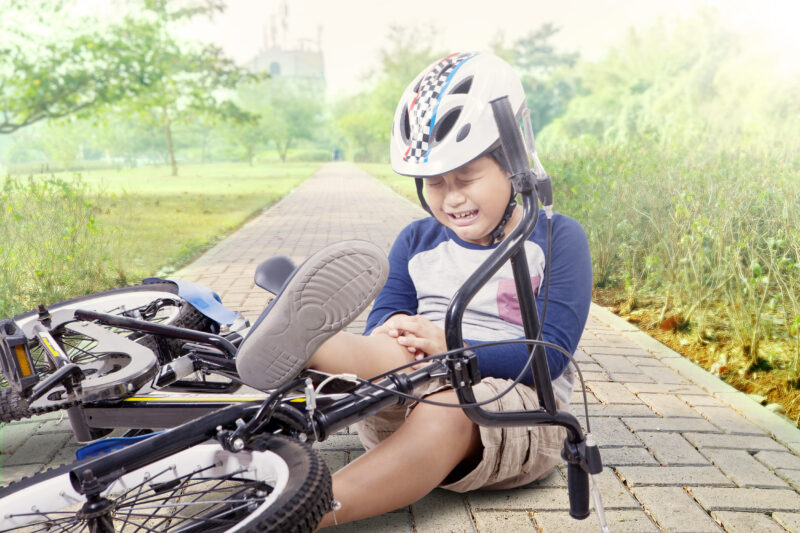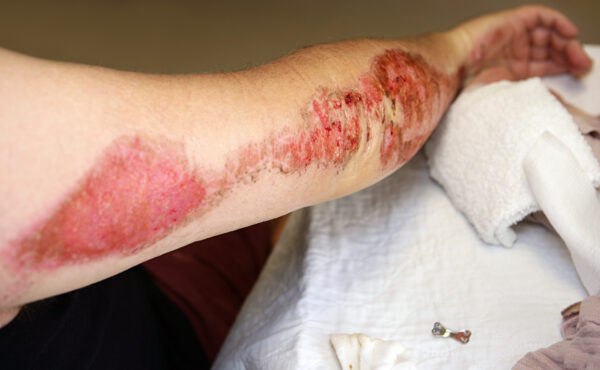 Skin abrasion. Road rash. Raspberries. Whatever you call it, this common childhood injury is in season. With high temperatures in spring and summertime, kids get outside more to play sports, ride bikes, skateboard and hop on dirt bikes — and wear less clothing, eliminating a protective skin barrier.
Skin abrasion. Road rash. Raspberries. Whatever you call it, this common childhood injury is in season. With high temperatures in spring and summertime, kids get outside more to play sports, ride bikes, skateboard and hop on dirt bikes — and wear less clothing, eliminating a protective skin barrier.
Road rash usually occurs when kids fall and their skin gets scraped against pavement (like falling off a bike) or dirt (sliding into home plate). Director of Akron Children’s Paul and Carol David Foundation Burn Institute Dr. Anjay Khandelwal also has seen several similar injuries from kids falling on moving treadmills.
“Road rash is actually a friction burn,” he said. “It doesn’t necessary mean there’s an injury from heat, although heat can be generated, but it requires treatment similar to a burn.”
Road rash looks like a huge scrape, may feel raw, become inflamed and can bleed a little. It can be very painful, more so than a puncture wound because it affects more nerve endings. The good news is when you take good care of the wound, keeping it clean and dry, medical treatment is not necessary and it usually heals without scarring in 10 to 14 days.
Treating road rash at home
In many cases, road rash is not a serious injury and can be treated at home. Keeping the wound clean to prevent infection is the main objective.
For optimal at-home treatment, Dr. Khandelwal recommends:
- Wash your hands first, then wash the wound using soap and luke-warm water to help prevent infection.
- Remove as much dirt and gravel from the wound as possible. You may need tweezers. Left untreated, debris can become permanently lodged in the wound, which can cause scarring or skin discoloration, or even lead to infection.
- Apply an antibiotic ointment, such as Bacitracin, to moisturize and prevent infection.
- Lastly, bandage the wound. A Band-Aid works for smaller injuries, or gauze is useful for larger ones. Covering the wound protects it from further skin damage or infection as it heals.
“It’s important to wash the wound and change the bandage daily to keep it clean, and it’s a good time to check for infection,” he said. “If the pain worsens or the wound stays red or starts to pus, you should contact your doctor.”

If the wound is about 2 times larger than the palm of your hand, seek medical treatment. Severe injuries and the pain that comes with them can be difficult to treat at home.
When to seek medical care for road rash
In some cases, road rash can occur from major injuries, such as kids falling off motorized vehicles or car crashes, and need immediate medical attention. When the injury is severe, affecting several layers of skin, wounds — and severe pain — can be difficult to treat.
Head to the nearest Urgent Care or Emergency Room if:
- The wound covers a large area of the body, more than 2 times bigger than the palm of your hand.
- You can’t remove all the dirt and gravel from the wound.
- The pain is too great to manage at home.
- The cut is deep or there is excessive bleeding. If the cut turns pale pink or white, that’s a sign it could be deeper than you might think.
- The wound hasn’t healed in 10 to 14 days.
- There are signs of infection, such as pus or fever.
“Road rash can be tricky injuries to diagnose, so when in doubt, seek medical care,” warned Dr. Khandelwal. “Severe cases should be treated as a burn, which many don’t realize could require surgery or skin grafting.”
Preventing road rash
Don’t let road rash get in the way of your summer fun. The best way to treat road rash is to prevent it in the first place. Dr. Khandelwal recommends parents ensure kids:
- Wear protective clothing that covers their legs and arms.
- Wear a helmet, knee and elbow pads.
- Use caution and stay within speed limits when riding motorized vehicles.
If your child’s road rash injury needs medical attention, head to an Akron Children’s Urgent Care or Emergency Room. Not sure where to go? Use these general guidelines.
Akron Children’s treats adult burn patients, as well, and sees many with road rash injuries, particularly from dirt bikes and motorcycles. Adults should never operate a vehicle under the influence.










